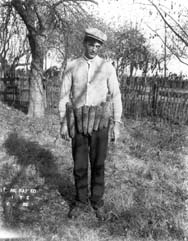Analysis of a Historical
Photograph Lesson
Objective: to retrieve social, cultural, and historical information
from a photograph by analyzing the contents in the method described
below.
Grade level: Middle School and up
Time Required: one to two class periods
Motivation: If one is researching an historical subject, such
as family or town history, old photographs are one type of primary
document that yields information about people, events, culture, and
places. Armed with a set of questions, a researcher can glean information
that complements, fills in, and enriches the written record.
ONLINE Collections: https://www.museum.state.il.us/exhibits/sadorus/photogallery
Sadorus Photograph Collection
https://www.museum.state.il.us/muslink/art/htmls/dd.html
Double Exposure Photographic module
Other Sources: https://memory.loc.gov/ammem/ndlpedu/educators/workshop/discover/index.html
American Memory Project Lessons on Primary Source Use
Bial, Raymond. Upon a Quiet Landscape: The Photographs of Frank
Sadorus. Urbana, Illinois, Champaign County Historical Archives,
1983. (Book and video) https://angelfire.com/id2/tetons/granpapsadorus.html
Henry S. Sadorus Life History https://www.sadorus.com
Sadorus, Illinois Web pages with history and photo gallery.
 Procedure:
Guidelines for Analysis
Procedure:
Guidelines for Analysis
1. Identify a photograph by inspection:
Is there any written identification such as a title, signature, date,
or comment in or on the photographic print?
Where was the photograph found - family album, archival library, someone's
estate, in a sale?
What clues, if any, does the source give you?
Using your knowledge or research information about the art or technology
of photography, what do you discern may be the approximate date of
the photo?
2. Identify the contents of the photographic composition by inspection:
Are there any people in the photograph? What are they doing? What
are they wearing? Where are they? How are they interacting?
Is it a candid or posed composition?
3. Try to discern the purpose for the photograph:
Was it personal, to be published?
Does the photograph illustrate an event, an action, an occupation,
a celebration?
Does it appear to be an amateur, a commercial or a professional photograph?
The paper on which it is printed or the frame or ablum the photgraph
is in may give you clues.
4. Analyze the composition:
Divide the composition into several sections and list the objects
in each section.
Classify the objects into types or categories (e.g., work and tools,
family members and associated memorabilia).
Decide which details give historical or cultural meaning to the photograph
and describe in words.
5. Interpret/Evaluate the photograph:
What, if any, deductions, inferences, specific information, or generalizations
can you make about the subject of the photograph and the photograph
as a whole as an historical document?
What questions for further research does the photograph prompt?
What cultural information does the photograph contain? Examples: humor
("Double Exposure of Warren"), pun ("I grew Up in the Corn Belt"),
joke ("Warren Sadorus-Post No Bills Here"), drama, pose, action ("The
Punkin Orchestra"), game ("April 18, 1910" depicts a coming snowball
fight), sport, costume, custom ("Christmas Treats"), printed matter
("GWB Sadorus reading"), architecture ("Sadorus Home")
Assessment
(Use of this analysis tool in research reports): This exercise is
a learning tool in preparation for doing primary research. Students
should feel comfortable after analyzing several photographs in this
manner. Options for use of this information in their research: 1)
use as an interpretive caption when including the photograph in their
report; 2) integrate the information from the analysis directly as
text; 3) use multiple images for cultural and historical interpretation
or inferences.
Analysis
should reflect the visible details of the photograph and be backed
up with written material when possible. (For example, for "The Card
Players," What card games were popular in 1910? Which game does the
hands and discard motions indicate it might be? Research rules of
games.)
Illinois State Board of Education Standards:
Social Science 18: A. Compare characteristics of culture as reflected
in language, literature, the arts, traditions and institutions.
Middle School: 18.A.3 Explain how language, literature, the
arts, architecture and traditions contribute to the development and
transmission of culture.
Early High School: 18.A.4 Analyze the influence of cultural
factors including customs, traditions, language, media, art and architecture
in developing pluralistic societies.
Late High School: 18.A.5 Compare ways in which social systems
are affected by political, environmental, economic and technological
changes.
18.B. Understand the roles and interactions of individuals and
groups in society.
Middle School: 18.B.3a Analyze how individuals and groups interact
with and within institutions (e.g., educational, military). 18.A.3b
Explain how social institutions contribute to the development and
transmission of culture.
Worksheet
for Photographic Analysis:
|
Content
|
Purpose
|
Date
|
Origin and/or written information
|
|
Analysis and Evaluation Notes:
|

